|
|
|
|||
|
|
||||
|
|
||||
| The (Jet)X Files | ||||
|
|
HOME | SITE MAP | FORUM | CONTACT |
|
||
|
ABOUT | MOTORS | MODELS | ARCHIVE | HISTORY | STORE | FAQ | LINKS
|
|
|
|
|
|
|||||||||||||||||||||||||||||||||||||||||||||||||||||||||||||||||||||
|
The (Jet)X Files 5
(May 2003)
by Roger Simmonds Reprinted from SAM 35 Speaks, May 2003 Afterburning It may be thought that model aircraft powered by rockets are a recent aberration, and that this means of propulsion does not have so noble or a past as, say, rubber power. This is not so, and I am pleased to reveal in an exclusive for SAM 35 Speaks that the true progenitor of our hobby is Mr F W Thomas, who demonstrated a rocket propelled model at Crystal Palace in 1907 (see photo below). |
|
|||||||||||||||||||||||||||||||||||||||||||||||||||||||||||||||||||||
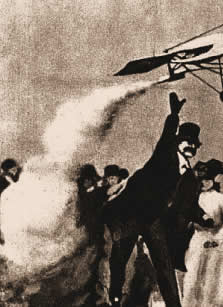
|
|
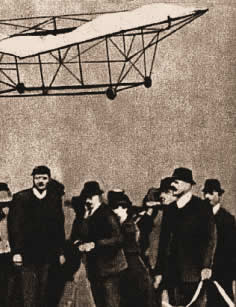 Mr F W Thomas launches his rocket propelled model aeroplane at a meeting at the Crystal Palace, London, in 1907
- RAF Flying Review, 1958 (digitally enhanced)
|
||||||||||||||||||||||||||||||||||||||||||||||||||||||||||||||||||||
|
The many innovative offerings of Wilmot, Mansour & Co. (WM) continue to intrigue readers. I had an email from Tony Betts (Physics of Flight) who produces a “kit of parts” for the Meteor (for two Jetex 50’s), and the SARO A/1 (right) discussed in my January column. Tony has built one of the latter exactly as the plan for Rapier L-2 power. It weighs about 62 g (doped but unpainted) and initial flights are promising, with 3-4 circuits before ‘arrival’. Tony then said laconically he will "have to glue the wing back on". ’Twas ever thus, I’m afraid, trimming rocket planes. Tony’s website lists a range of kits suitable for Rapier power and is another ‘must visit’ site for us jet jockeys. He tells me that he has sold ten kits for the SARO A/1, so I hope we will soon have the joy of seeing these fly at Old Warden and other meetings. |
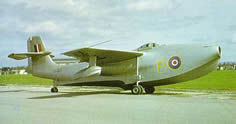 The full-size SARO A/1 as it appears on Tony Betts’ website |
|||||||||||||||||||||||||||||||||||||||||||||||||||||||||||||||||||||
|
|
|
||||||||||||||||||||||||||||||||||||||||||||||||||||||||||||||||||||||||||||
Whilst an early WM essay in moulded fuselages, the so called ‘Zyra’ spacecraft (right), appeared in 1951, the ‘Tailored’ kits proper started in 1953 with the F-88A Voodoo for Jetex 50. Development and production of these models continued until at least 1959/60. I have been trying to compile a definitive list of these models, and progress so far is shown in the following table:
* for Jetmaster The unique feature of these kits was of course the moulded fuselage halves and enclosed motor with augmenter tube. The general consensus is that these kits looked wonderful but required careful and expert building, and tended to be small and heavy for the Jetex 50 (I would surmise that the weights quoted are without the motor). None flew well in the conventional sense, though the Voodoo and F.D.2 appear to be better than the others, but that said, any flights were exciting and inspirational. As can be seen, there are some gaps in the data, and I would be very grateful if readers can help with details, or even photos, of models. The Skyrocket (above right) is a surprising choice for a model with an augmenter tube, given its ‘vestigial’ air intakes of the original, but Mike Ingram, the designer, added an extra air intake at the windscreen, a most clever wrinkle. |
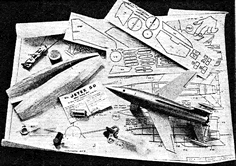 Wilmot Mansour’s “wonderful space ship Zyra”, with kit contents showing the moulded balsa shells – the first outing for ‘Tailored’ technology
- Aeromodeller, Dec. 1951
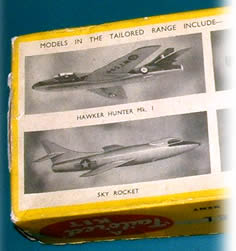 Underside of a ‘Tailored’ kit, showing two of the models in the range
- Andy Blackwell
|
||||||||||||||||||||||||||||||||||||||||||||||||||||||||||||||||||||||||||||
|
The F-104 Starfighter (right) is perhaps the most challenging and interesting design of all. Some modern designs, exemplified by the Bell XS-1 and Miles M.52, have stubby wings and long fuselages. These features are a popular modern recipe for a successful and stable model, but is the Starfighter taking this paradigm a little too far? Could it be trimmed to fly the same way? Historically, experienced modellers have tended to avoid designs which have long noses, small wings and weight distributed evenly about the longitudinal axis as these are prime candidates for inertia, or ‘roll’, coupling, where a disturbance about one axis (for example pitch) causes a disturbance about another axis (for example yaw). Inertia coupling plagued designers of the early high performance jets, and the Bell X-1A, X-2, Skyrocket, Douglas X-3 and even the Super Sabre were prone to instability and tumbling at high speed. Whether this exact phenomenon affects our models is not clear, but we do perhaps see something similar when any stalling tendency in a model rolls it into a flat inverted spin. Generally, this is terminal, but if enough altitude has been gained, a partial recovery followed by a repeat performance is possible. To aid a discussion of models with possibly ‘extreme’ features and try to predict whether they are viable, a number of analogous designs compatible with the Rapier |
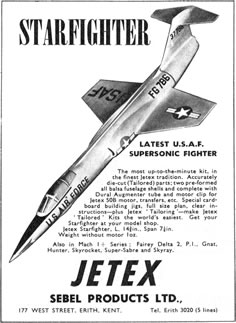
- RAF Flying Review, June 1958 (p. 7)
|
||||||||||||||||||||||||||||||||||||||||||||||||||||||||||||||||||||||||||||
* For L1 ** Swept back wings ***Joseph H Wherry |
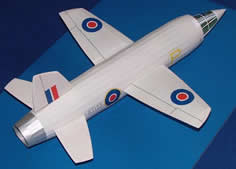 John Digby’s Miles.52 to Richard Crossley’s design
- John Digby
|
||||||||||||||||||||||||||||||||||||||||||||||||||||||||||||||||||||||||||||
|
The Miles M.52 (above right), and the Bell XS-1 and its derivatives are well-proven designs and will fly well in wide circuits at pretty much a constant height. The Douglas Skyjet, a low wing design is marginally less stable, whilst the Leduc 021 (right), of similar size and shape to the XS-1, has a very flat glide, perhaps a result of the straight-through ducting and consequent low profile drag from the fuselage. Graham Knight had a foam and balsa Heinkel 178 for |
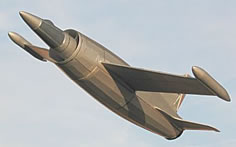 Roger Simmonds’s Leduc 021
- Roger Simmonds
|
||||||||||||||||||||||||||||||||||||||||||||||||||||||||||||||||||||||||||||
|
These sorts of considerations may not apply to models with swept wings. Some designers were initially very suspicious of the effect of swept wings on their models. Phil Smith argued in the 1951 Aeromodeller Annual, “sweepback as incorporated in most supersonic jet fighters is far too great for lateral stability in scale models and must be ‘tempered’ to an amount not exceeding 25 degrees on the leading edge”. He maintained that “this can usually be done without detracting greatly from the plan form of such a design as the Sabre, whose normal sweepback is 38 degrees”. Readers with access to photos of the Veron Sabre will draw their own conclusions. Mike Ingram thought differently, and his design of the Douglas Skyrocket keeps the 41 degrees of sweepback of the full size prototype. I know of two other Skyrocket designs. Richard Crossley designed one a few months back for |
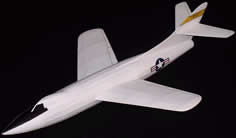 Adam Jenik’s Skyrocket to Richard Crossley’s design
- Adam Jenik
|
||||||||||||||||||||||||||||||||||||||||||||||||||||||||||||||||||||||||||||
|
Returning to straight wing designs, the Bell X-3 may look ridiculous, but Reg Boor had a plan in the fifties. This was never published, but it is (according to Richard): “complete, and [it] is nice … perhaps with a bit of lightening it would fly”. The only Starfighter model I have seen was an exciting fast climbing catapult glider, but these models have set up and stability criteria different from a powered model, and the two cannot really be compared. However, it is such an attractive prototype (though not so innovative in shape as was thought, given the Bristol Type 178) that WM could not resist the temptation, though they must have realised the potential difficulties. Like some other models of the fifties, it must have been considered a prestige project, and there is some doubt if the kit ever made it to the shops (though see the advertisement from 1958 above). Some small liberties have been taken, as the intakes opened up (see right) and the area of the solid sheet wing subtly increased, but it looks most realistic. I would love to hear that the WM Starfighter actually flew well, but I suspect the best one could have from it was an extended powered glide. I hope the above discussion provides food for thought about what sorts of designs may be possible, and stimulate some brave soul to attempt a new X-3 or Starfighter! |
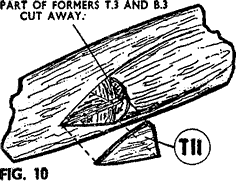 Jetex Tailored Starfighter – detail of air intake from the construction plan |
||||||||||||||||||||||||||||||||||||||||||||||||||||||||||||||||||||||||||||
|
The earliest Jetex scale model, the Meteor IV, was discussed in a previous column. The next Aeromodeller plan, published in July 1952 (were there others?) was D P Golding’s lovely D.H. 108 “Swallow” for Jetex 100 (right). This looked a much better bet to a small boy, well, this small boy anyway, though again the designer had taken care not to make things too easy, as the motor was mounted internally without augmenter tube. When did the trough first become ubiquitous and who was responsible for this eminently sensible though, possibly offensive, innovation? I bought the plan, but the fuselage, which is of ‘hollow log’ construction (which you will have guessed is a particular dislike of mine) put me off. However, I never forgot this design, and when I returned to small model jets this was my first attempt at an “own design” after learning the basics with a MiG 15. A brief description of the conversion of the D.H. 108 Swallow to Rapier L-2 power may encourage others to try one. |
 D P Golding’s D.H. 108 for Jetex 100
- Aeromodeller, July 1952 (p. 399)
|
||||||||||||||||||||||||||||||||||||||||||||||||||||||||||||||||||||||||||||
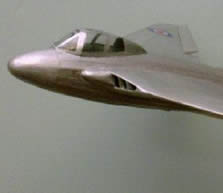
The model now weighed 35 g, which is quite reasonable for the L-2. The elevons were then finely adjusted for a flat straight glide without motor (on the flying field), whereupon, I was pleased to note, they matched the reflexed tip rib of the plan. The first powered flight showed the need for some more ‘up’ for a steady climb and the second the need for a bit of trim tab to correct a slight turn. The simplicity of this procedure was very gratifying. The flight pattern remains exciting and not altogether predictable, and like most of these sorts of models, periodic and subtle retrimming seems to be required. I make no claims for the Swallow’s originality or my expertise (Chris Strachan has a beautiful Swallow for L-1), but it really was wonderful to see this classic design flying again. I would like now to try a ‘superscale’ Mk 3 (the speed record holder) with, in emulation of the original and in deference to a fine original design, a buried motor. Meanwhile, I must build a model for the R30 competition. I’m tempted to try a reduced Veron Verosonic (right), my first really successful model, but sanity may prevail and I’ll build an Arrow instead. It will be wonderful to see a reaction motor duration competition again. Perhaps in view of our roots it should be for the “F W Thomas Memorial Trophy”. |
|
 The author’s D.H. 108 Swallow for Rapier L-2, in simulated flight (above) and actual flight (below) 
- photographs: upper - Roger Simmonds
lower - Andy Blackwell 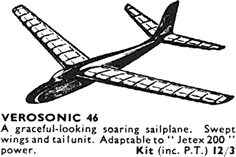
- Aeromodeller, March 1949
|
|||||||||||||||||||||||||||||||||||||||||||||||||||||||||||||||||||||||||||
|
|
|||||||||||||||||||||||||||||||||||||||||||||||||||||||||||||||||||||||||||||
|
|
|
||||||||||||||||||||||||||||||||||||||||||||||||||||||||||||||||||||||||||||
|
|
|
|
|
|
|
|
Acknowledgements - Article: Roger Simmonds - Illustrations: Roger Simmonds, Tony Betts, Andy Blackwell, John Digby, MAAC archives via Bill Henderson |
|
|
|
|
ABOUT | MOTORS | MODELS | ARCHIVE | HISTORY | STORE | FAQ | LINKS |
|
|
Terms of Use
|
Queries? Corrections? Additions?
Please
contact us.
|
|